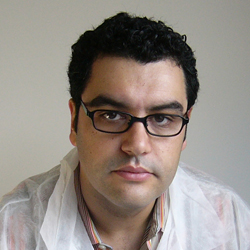| |
| |
| Rui M. Costa, D.V.M., Ph.D., Investigator |
 |
Dr. Costa received his D.V.M. from the Technical University of Lisbon in 1996. He entered the GABBA graduate program from University of Porto in 1997, and performed his Ph.D. studies with Dr. Alcino Silva at UCLA from 1998 to 2002 in the field of learning and memory, investigating the molecular and cellular mechanisms underlying the learning disabilities associated with NF1. He then joined Dr. Miguel Nicolelis at Duke University for his postdoctoral training, where he established multi-site neuronal recordings in awake behaving mice. Dr. Costa received the Young Investigator Award from the National Neurofibromatosis Foundation in 2001, and was a finalist of the Lindsley Prize from the Society for Neuroscience in 2003. Dr. Costa joined NIH in January 2006. His laboratory studies the neurobiology of action in health and disease.
|

|
Staff:
- John Burkhardt, Graduate Student burkhardtj@mail.nih.gov
- Guohong Cui, M.D., Ph.D., Postdoctoral Fellow fellow cuig@mail.nih.gov
- Eduardo Dias Ferreira, Doctoral Student from the BEB PhD Program eddifer@ecsaude.uminho.pt
- Monica Hilario, Ph.D., Postdoctoral Fellow hilariom@mail.nih.gov
- Terrell Holloway, Technical IRTA hollowaytd@mail.nih.gov
- Xin Jin, Ph.D., Postdoctoral Fellow jinx@mail.nih.gov
- Amber Luo, M.D., Research Associate gluo@mail.nih.gov
- Michael Pham, PostBac Irta in collaboration with Dr. Vogel phamm2@mail.nih.gov
- Shweta Prasad-Mulcare, Postbaccalaureate IRTA shweta@mail.nih.gov
Research Interests:
The Section on In Vivo Neural Function studies the neurobiology of action in health and disease. Our overall goal is to understand how changes in molecular networks in the brain modify neural circuits to produce experience-dependent changes in actions. We are particularly interested in investigating the corticostriatal mechanisms underlying the learning and flexible use of actions, e.g. how new actions and skills are learned, how they are voluntarily initiated, how they can be associates with particular outcomes, and how eventually they can become habitual. We seek to investigate these problems using and integrative approach spanning from molecules to circuits, where we monitor and manipulate the activity of molecules, neuronal circuits, and behavior. We chose to implement this integrative approach in mice because they combine the power of genetics, a mammalian brain with layered structures that can generate oscillatory activity, the possibility of accurately quantifying simple behaviors like action initiation and stereotypic skill learning, and also more elaborate behaviors like goal-directed actions. Our specific goals are:
- To investigate the molecular, cellular, and circuit mechanisms mediating the different phases of action and skill learning.
- To study the corticostriatal mechanisms underlying dopamine control of voluntary movement and goal-directed navigation.
- To investigate the relationship between actions and rewards, in particular the differences between goal-directed actions and habits, as well as the mechanisms of addiction (e.g. alcoholism).
- To study the alterations in corticostriatal function in different neurodegenerative and psychiatric disorders in-vivo.
In order to have an understanding of the mechanisms of action from molecules to systems we develop new genetically modified mice to manipulate and visualize plasticity in corticostriatal circuits, and new tools for in-vivo multi-site recording of corticostriatal neuronal ensembles in behaving mice.
Dr.Costa's NIAAA Homepage
|
Selected Recent Publications:
Hilario, M., Clouse, E., Yin, H.H., Costa, R.M. (2007) Endocannabinoid signaling is critical for habit formation, Frontiers in Integrative Neuroscience 1:6, doi: 10.3389/neuro.07/006.
Costa, R.M., Lin, S.C., Sotnikova, T.D., Cyr, M., Gainetdinov, R.R., Caron, M.G., Nicolelis M.A.L. (2006) Rapid alterations in corticostriatal ensemble coordination during acute dopamine-dependent motor dysfunction., Neuron 52(2), 359-69.
Costa, R.M., Drew, C. and Silva, A.J. (2005) To Remember or Notch to Remember., Trends in Neurosciences, 28, 429-35.
Costa, R.M., Cohen, D., Nicolelis M.A.L. (2004) Differential corticostriatal plasticity during fast and slow motor skill learning in mice., Current Biology 14(13), 1124-34.
Costa R.M., Honjo T., and Silva A.J. (2003) Learning and memory deficits in Notch mutant mice. , Current Biology 13 (15), 1348-54.
Costa, R.M., Federov, N.B., Kogan, J.H., Murphy, G.G., Stern, J., Ohno, M., Kucherlapati, R., Jacks, T. and Silva, A.J. (2002) Mechanism for the learning deficits in a mouse model of neurofibromatosis type 1, Nature, 415 (6871) 415 (6871), 526-30.
All Selected Publications
Contact Information:
Dr. Rui M. Costa
Section on In-Vivo Neural Function
Laboratory for Integrative Neuroscience - NIAAA
5625 Fishers Lane, Room TS-20D,MSC 9411
Bethesda, MD 20892-9411
Telephone: (301) 443-1196 (office),
(301) 480-0466 (fax)
Email: costarui@mail.nih.gov
|
|















